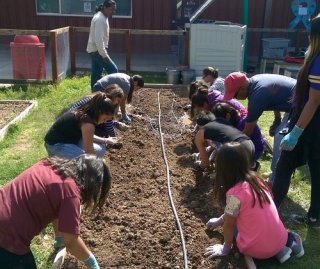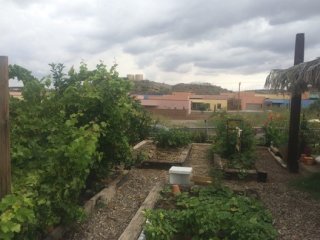Local Foods, Local Places Case Study: Ajo, Arizona
The rural community of Ajo, Arizona, is in the middle of the Sonoran Desert, just 43 miles from the Mexican border. In 2015, the community leveraged Local Foods, Local Places planning assistance to plan for an expansion of grassroots local food production and entrepreneurship.
Ajo boomed as a copper-mining town at the turn of the 18th century, and the mine ended production in 1985. As of 2015, Ajo had a population of fewer than 4,000 people.
The Ajo Regional Food Partnership formed in 2009, aiming to enhance residents’ health, well-being, and food security. The diverse group of partners included nonprofit organizations, the local school district, a health center, the library, and the county parks and recreation department. The group began with nutrient-poor, contaminated soils in an area that sees little rainfall and had no recent history of agriculture.

The partnership created a widely distributed network of local food sources under the stewardship of many individuals and groups. This network included backyard gardens, community gardens and farms, farmers markets, grocery stores, restaurants, and food pantries/banks. The hub for many of these activities was the nonprofit Ajo Center for Sustainable Agriculture’s Many Hands Urban Farm and Learning Center, where the community helped create gardens, orchards, and a chicken coop. All of the growing areas served as demonstration sites and growing sites for Sonoran Desert heirloom crops.
The learning center also hosted after-school Kids at the Farm programming, where children and their families grew their own food and learned about healthy food preparation. The Ajo Center for Sustainable Agriculture is on the property of the Sonoran Desert Inn and Conference Center. The inn’s renovation in 2015 created a job-training site for community residents. A commercial kitchen was added a year later to serve the inn, provide space for cooking classes and demonstrations, and give market vendors a place to create prepared foods and value-added products.

In part due to the action planning at the 2015 Local Foods, Local Places workshop, the partnership’s efforts increased the amount of food-producing land fourfold, from 10,000 to 40,000 square feet in just six years. Food food production expanded eightfold, from 1,000 to 8,000 pounds per year. In 2016, at least 500 local families (more than one-quarter of all Ajo households) were involved with growing, selling, processing, and/or buying local foods.
The benefits have extended far beyond food. The Authentically Ajo Farmers Market served as a community gathering space and incubated 70 food vendors in a town with extreme poverty and few job opportunities. The market, learning center, and other gardens were instrumental in revitalizing and greening the town while fostering hope for the future. The farmers market held in the town plaza attracted around 400 customers weekly during the height of the season and helped increase sales for plaza businesses. In addition, the annual Ajo Food Festival attracted more than 1,000 visitors, including from Phoenix and Tucson, and became Ajo’s largest community festival.
LESSONS LEARNED
- Local foods can be the basis for community revitalization in all types of climates.
- A diverse partnership allowed the effort to reach deep into the community and achieve multiple community goals.
- Community participation in building backyard and community gardens generated support to sustain the partnership’s efforts.
Published July 2017
Source: Personal communication with Nina Sajovec, Executive Director, Ajo Center for Sustainable Agriculture.
This case study appears in the Local Foods, Local Places Toolkit.
